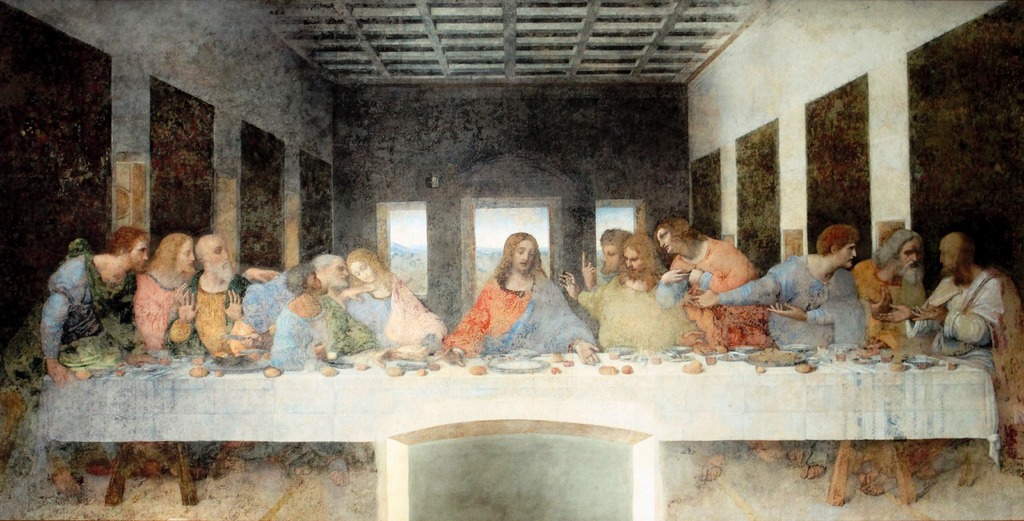Somewhere around 1495, Leonardo DaVinci began painting a wall for a Dominican monastery in Milan, Italy. The result of his multi-year labor is the most recognizable piece of art ever created – The Last Supper. Time and elements have ravaged the image DaVinci created, and details have slowly become lost. The painting itself depicts the moment when Jesus announces, “I tell you the truth, one of you will betray me!” That moment is also the text for today’s exploration of John’s Gospel.
The next few verses unfold after the teachable moment of Jesus washing the Disciples’ feet. “Now Jesus was deeply troubled, and he exclaimed, “I tell you the truth, one of you will betray me!” The disciples looked at each other, wondering whom he could mean. The disciple Jesus loved was sitting next to Jesus at the table. Simon Peter motioned to him to ask, “Who’s he talking about?” So that disciple leaned over to Jesus and asked, “Lord, who is it?” Jesus responded, “It is the one to whom I give the bread I dip in the bowl.” And when he had dipped it, he gave it to Judas, son of Simon Iscariot. When Judas had eaten the bread, Satan entered into him. Then Jesus told him, “Hurry and do what you’re going to do.” None of the others at the table knew what Jesus meant. Since Judas was their treasurer, some thought Jesus was telling him to go and pay for the food or to give some money to the poor. So Judas left at once, going out into the night.” (John 13:21–30, NLT) It is a highly emotional and dramatic moment, which may be what drew DaVinci to use it as the inspiration for his masterpiece.
One of the things we often lose as we read the Bible are the emotions of the people in the story. Jesus, we are told, was deeply troubled. The words John chose indicated a troubling or stirring of spirit. Other emotions of the moment include shock, wonder, and perhaps fear.
And now we turn to Judas. Jesus chose Judas Iscariot as one of His twelve close disciples. He walked with Jesus, ate with Him, heard Jesus teach, and saw many miraculous events. So why did Judas betray Jesus? Why did he entertain the whispers of satan? Folks often try to condense Judas to a single motive, but I think he was much more complex than that.
In one sense, Judas thought he was doing the right thing. Perhaps he was greedy, as John suggests. Or perhaps he desired to force Jesus’ hand to exercise His divine powers to kick out the Romans. The truth is probably some amalgamation of both of these.
Now, we know what happens later. Judas accepted payment to identify and betray Jesus. In the dark of night at the Garden of Gethsemane, Judas identified Jesus to the arresting soldiers with a kiss. After observing the events of Jesus’ trials, torture, and crucifixion, Judas rejected the payment and, with deep regret, committed suicide.
But are we really that much different than Judas? I hope that question gives you pause. The attitudes and desires of Judas are ever-present. The desire by some in the church for the gain of money, power, sex, or reputation still brings division and destruction. The desire is still with us to force God’s hand towards a longed-for outcome, which ultimately poisons our relationship with God and others. All of us can fall prey to the same attitudes and desires that befell Judas.
There is light, however, in the darkness. Judas could have made other choices. God’s plan wouldn’t have been undone; it would have just unfolded in a different way. It is my personal belief that Jesus would have forgiven Judas if he had been honest, humble, and repentant. But Judas’ besetting sin of pride was, in the final analysis, his undoing. His pride convinced him that he was only taking what was owed him when he stole from the treasury. Judas’ pride assured him that he was the one to be the kingmaker, the one to force Jesus into fully revealing His power and authority.
You see, Judas didn’t betray Jesus just one time but many times. Little pride-filled choices led to an ultimate betrayal. In a way, it is just like DaVinci’s grand artwork that was created one brushstroke at a time.
- Mark: Consider the Sower - May 28, 2025
- Mark – Family Matters - May 26, 2025
- Mark: A House Divided - May 22, 2025




